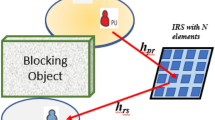Abstract
The objective of cooperative spectrum sensing is to collaboratively detect the presence of the primary user by the aid of multiple secondary users. It is known that the performance of such a framework substantially depends on the fading assumption. In this paper, we propose an advanced framework for linear cooperative spectrum sensing in cognitive radio networks over correlated log-normal shadow fading channels. Considering the realistic sensing and reporting channels which are not addressed in similar works, motivates us to propose a novel approximation for correlated log-normal sum based on moment generating function calculation and moment matching method. Furthermore, the linear cooperative spectrum sensing coefficients are computed based on the optimization of the deflection criterion. This results in a framework with reasonable complexity which is suitable for practical applications. Simulation results show the excellent agreement between the exact and approximated statistics and the superior performance compared with conventional equally gain combiner.







Similar content being viewed by others
References
Haykin, S. (2005). Cognitive radio: Brain-empowered wireless communications. IEEE Journal on Selected Areas in Communications, 23(2), 201–220.
Goldsmith, A., Jafar, S. A., Maric, I., & Srinivasa, S. (2009). Breaking spectrum gridlock with cognitive radios: An information theoretic perspective. Proceedings ofthe IEEE, 97(5), 894–914.
Asadduzzaman, Kong, H. Y., & Lyum, K. (2010). Cooperative relaying in interference limited cognitive radio networks. In Proceedings IEEE international conference on wireless and mobile computing, networking and communications (WiMob) (pp. 280–285).
Jamali, V., Golkar, B., Salari, S., Ahmadian, M. & Sousa, E. S. (2012). Cooperative spectrum sensing with per-user power constraints. In Proceedings of IEEE personal, indoor and mobile radio communication (PIMRC) (pp. 1559–1564).
IEEE 802.22, Working group on wireless regional area networks (WRAN): http://grouper.ieee.org/groups/802/22/.
Urkowitz, H. (1967). Energy detection of unknown deterministic signals. Proceedings of the IEEE, 55(4), 523–531.
Gavrilovska, L., & Atanasovski, V. (2011). Spectrum sensing framework for cognitive radio networks. Wireless Personal Communications, 59, 447–469.
Sahai, A. & Cabric, D. (2005). Spectrum sensing: Fundamental limits and practical challenges. In Proceedings of IEEE international symposium new frontiers in dynamic spectrum access networks (DySPAN), Baltimore, MD.
Sutton, P. D., Nolan, K. E., & Doyle, L. E. (2008). Cyclostationary signatures in practical cognitive radio applications. IEEE Journal on Selected Areas in Communications, 26(1), 13–24.
Zhi, Q., Cui, S., & Sayed, A. H. (2008). Optimal linear cooperation for spectrum sensing in cognitive radio networks. IEEE Journal of Selected Topics in Signal Processing, 2(1), 28–40.
Zhi, Q., Cui, S., Sayed, A. H., & Poor, H. V. (2009). Optimal multiband joint detection for spectrum sensing in cognitive radio networks. IEEE Transactions on Signal Processing, 57(3), 1128–1140.
Unnikrishnan, J., & Veeravalli, V. V. (2008). Cooperative sensing for primary detection in cognitive radio. IEEE Journal of Selected Topics in Signal Processing, 2(1), 18–27.
Kim, H. & Shin, K. G. (2008). In-band spectrum sensing in cognitive radio networks: Energy detection or feature detection. In Proceedings ACM international conference on mobile computing and networking, pp. 14–25.
Ghasemi, A., & Sousa, E. S. (2007). Asymptotic performance of collaborative spectrum sensing under correlated log-normal shadowing. IEEE Communications Letters, 11(1), 34–36.
Jamali, V., Salari, S., Reisi, N., Cances J.-P. & Ahmadian M. (2011). Linear cooperation for spectrum sensing over correlated log-normal shadow fading channels. In Proceedings 14th international symposium on wireless personal multimedia communications (WPMC) (pp. 1–5).
Reisi, N., Jamali, V., Ahmadian, M. & Salari, S. (2011). Cooperative spectrum sensing over correlated log-normal channels in cognitive radio networks based on clustering. In Proceedings of the 11th international conference on telecommunications ConTEL.
Ma, J., Zhao, G., & Li, Y. (2008). Soft combination and detection for cooperative spectrum sensing in cognitive radio networks. IEEE Transactions on Wireless Communications, 7(11), 4502–4507.
Zhang, W., Mallik, R. K., & Letaief, K. B. (2009). Optimization of cooperative spectrum sensing with energy detection in cognitive radio networks. IEEE Transactions on Wireless Communications, 8(12), 5761–5766.
Zhang, W., & Letaief, K. B. (2008). Cooperative spectrum sensing with transmit and relay diversity in cognitive radio networks. IEEE Transactions on Wireless Communications, 7(12), 4761–4766.
Di Renzo, M., Imbriglio, L., Graziosi, F., & Santucci, F. (2009). Distributed data fusion over realistic sensing and reporting channels: Application to cooperative spectrum sensing among cognitive radios over correlated Log-Normal shadowing. IEEE Transactions on Wireless Communications, 8(12), 5813–5821.
Fenton, L. F. (1960). The sum of lognormal probability distributions in scatter transmission systems, IRE Transactions on Communications Systems, CS-8, 57–67.
Schwartz, S., & Yeh, Y. (1982). On the distribution function and moments of power sums with lognormal components. Bell System Technical, 61, 1441–1462.
Beaulieu, N. C., & Xie, Q. (2004). An optimal lognormal approximation to lognormal sum distributions. IEEE Transactions Vehicular Technology, 53, 479–489.
Mehta, N. B., Wu, J., Molisch, A., & Zhang, J. (2007). Approximating a sum of random variables with a log-normal. IEEE Transactions on Wireless Communications, 6, 2690–2699.
Cai, K. V., Phan, V., & O’Connor, R. J. (1989). Energy detector performance in a noise fluctuating channel. Proceedings of Military Communications Conference, 1, 85–89.
Abramowitz, M., & Stegun, I. (1972). Handbook of mathematical functions with formulas, graphs, and mathematical tables (9th ed.). NY: Dover.
Thomopoulos, N. T. & Johnson A. C. (2004). Some measures on the standard bivariate log-normal distribution. In Proceedings of Decision Science Institute.
Magnus, J. R., & Nedecker, H. (2007). Differential calculus with applications in statistics and econometrics (3rd ed.). London: Wiley.
Author information
Authors and Affiliations
Corresponding author
Rights and permissions
About this article
Cite this article
Jamali, V., Reisi, N., Ahmadian, M. et al. Optimization of Linear Cooperation in Spectrum Sensing Over Correlated Log-normal Shadow Fading Channels. Wireless Pers Commun 72, 1691–1706 (2013). https://doi.org/10.1007/s11277-013-1129-5
Published:
Issue Date:
DOI: https://doi.org/10.1007/s11277-013-1129-5




